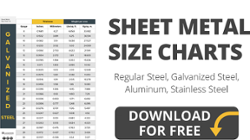Sheet metal design is key to the production of quality products. For manufacturers to come up with desirable, quality-compliant metal tools, they ought to follow specific guidelines. Whether you are fabricating military equipment or automobile parts, it’s essential to follow the stipulated guidelines.
This article takes you through Blackstone’s fundamentals of sheet metal design. Read on!
Bends
At Blackstone, we ensure the same direction occurrence of numerous bends for easier manufacturing. Also, we do not work with parts that have lower than necessary bent flanges because it might compromise product quality.
When processing sheet metal, we ensure that the bend radius at least half the thickness of the material.
Curls
Curling is the process of adding a circular roll to the edge of the sheet metal. Curled edges provide strength to the edge of the material for safer handling. The purpose of curls is to remove sharp, untreated edges. Blackstone’s curl guidelines are such that;
- The outside curl radius should not be lesser than twice the thickness of the material
- A curl’s distance from an internal bend should be at least 6x the thickness of the material plus the curl radius
- A curl’s distance from an external bend should be at least 9x the thickness of the sheet metal material plus curl’s radius
Flanges
Flanges make the metal part creation process quick and convenient. In the course of extracting a flange, these considerations are key;
- The minimum flange must be at least 4x the sheet metal thickness
- The minimum bent flange height is directly related to bend length, bend radius, and the thickness of the material
- The minimum relief bend width should be proportionate to the thickness of the material
Welding
At Blackstone, we restrict spot welding to joining coplanar surfaces.
We use 20x the thickness of the material as the distance between welds. Our lower end is usually 10x times the thickness of the material.
The distance between a weld and the edge should be at least 2x the diameter of the spot weld.
For Holes,
The minimum hole diameter should be equal to the thickness of the material.
The minimum distance between holes should be proportionate to the thickness of the material and shape and size of the hole feature.
The distance between the hole edge and the form should at least thrice the thickness of the material.
The hole to bend distance should be twice the thickness of the material plus the radius of the bend.
The distance between the leading edge and the bend should be equal to the thickness of the material plus the radius of the bend radius or twice the thickness of the material.
For Thrust out Holes,
The distance between two thrust-out holes should be at least 6x the thickness of the material.
The distance from a thrust-out hole to both the edge and the bend should be at least thrice the thickness of the material.
Hems
Blackstone uses hems to create folds in sheet metal. This helps stiffen edges for safer handling.
Our hem guidelines are such that;
- The thickness of the material should be equal to the inside diameter for teardrop hems
- The inside diameter should always be less than the thickness of the material for open hems
Why Sheet Metal Design Guidelines are Important
The above Blackstone’s guidelines are essential to achieve metal precision. The minimum guidelines are such that the manufacturer cannot afford to compromise material quality. All our sheet metal processes are bound by these guidelines.
For assistance in sheet metal design, contact us, and we will be willing to help!



